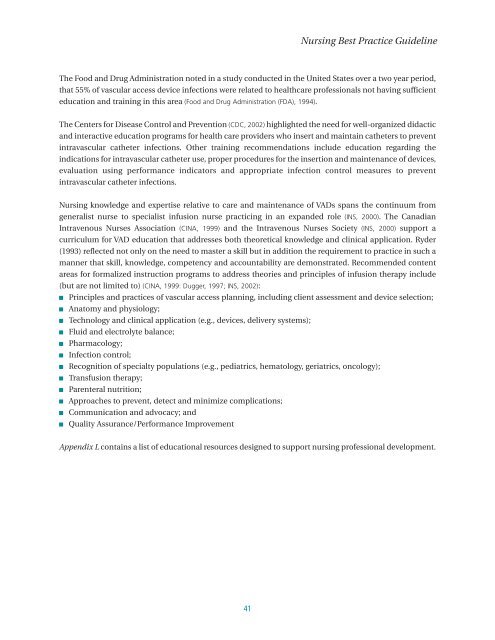Care and Maintenance to Reduce Vascular Access Complications
Care and Maintenance to Reduce Vascular Access Complications
Care and Maintenance to Reduce Vascular Access Complications
- No tags were found...
You also want an ePaper? Increase the reach of your titles
YUMPU automatically turns print PDFs into web optimized ePapers that Google loves.
Nursing Best Practice GuidelineThe Food <strong>and</strong> Drug Administration noted in a study conducted in the United States over a two year period,that 55% of vascular access device infections were related <strong>to</strong> healthcare professionals not having sufficienteducation <strong>and</strong> training in this area (Food <strong>and</strong> Drug Administration (FDA), 1994).The Centers for Disease Control <strong>and</strong> Prevention (CDC, 2002) highlighted the need for well-organized didactic<strong>and</strong> interactive education programs for health care providers who insert <strong>and</strong> maintain catheters <strong>to</strong> preventintravascular catheter infections. Other training recommendations include education regarding theindications for intravascular catheter use, proper procedures for the insertion <strong>and</strong> maintenance of devices,evaluation using performance indica<strong>to</strong>rs <strong>and</strong> appropriate infection control measures <strong>to</strong> preventintravascular catheter infections.Nursing knowledge <strong>and</strong> expertise relative <strong>to</strong> care <strong>and</strong> maintenance of VADs spans the continuum fromgeneralist nurse <strong>to</strong> specialist infusion nurse practicing in an exp<strong>and</strong>ed role (INS, 2000). The CanadianIntravenous Nurses Association (CINA, 1999) <strong>and</strong> the Intravenous Nurses Society (INS, 2000) support acurriculum for VAD education that addresses both theoretical knowledge <strong>and</strong> clinical application. Ryder(1993) reflected not only on the need <strong>to</strong> master a skill but in addition the requirement <strong>to</strong> practice in such amanner that skill, knowledge, competency <strong>and</strong> accountability are demonstrated. Recommended contentareas for formalized instruction programs <strong>to</strong> address theories <strong>and</strong> principles of infusion therapy include(but are not limited <strong>to</strong>) (CINA, 1999: Dugger, 1997; INS, 2002):■■■■■■■■■■■■Principles <strong>and</strong> practices of vascular access planning, including client assessment <strong>and</strong> device selection;Ana<strong>to</strong>my <strong>and</strong> physiology;Technology <strong>and</strong> clinical application (e.g., devices, delivery systems);Fluid <strong>and</strong> electrolyte balance;Pharmacology;Infection control;Recognition of specialty populations (e.g., pediatrics, hema<strong>to</strong>logy, geriatrics, oncology);Transfusion therapy;Parenteral nutrition;Approaches <strong>to</strong> prevent, detect <strong>and</strong> minimize complications;Communication <strong>and</strong> advocacy; <strong>and</strong>Quality Assurance/Performance ImprovementAppendix L contains a list of educational resources designed <strong>to</strong> support nursing professional development.41
















